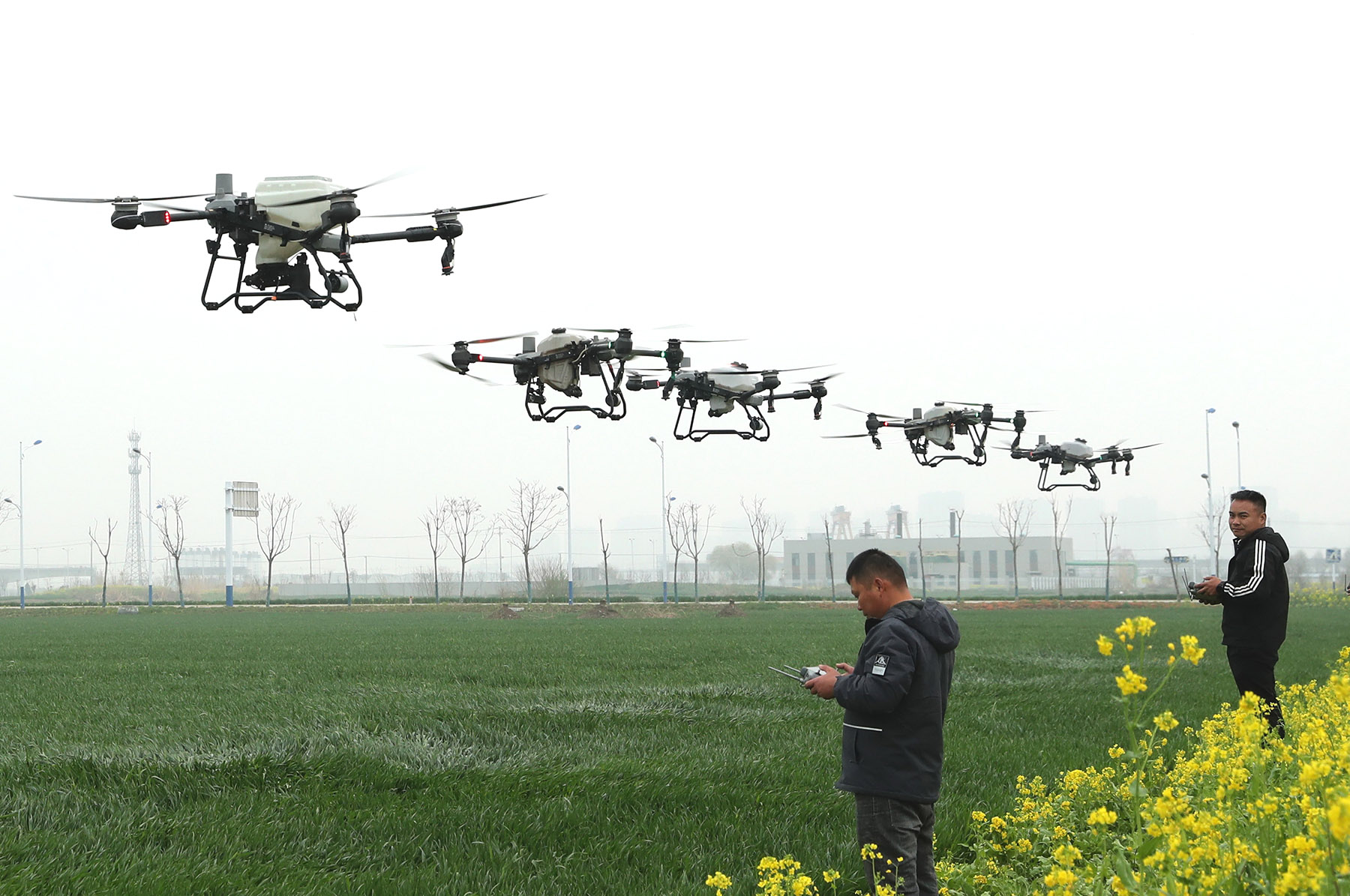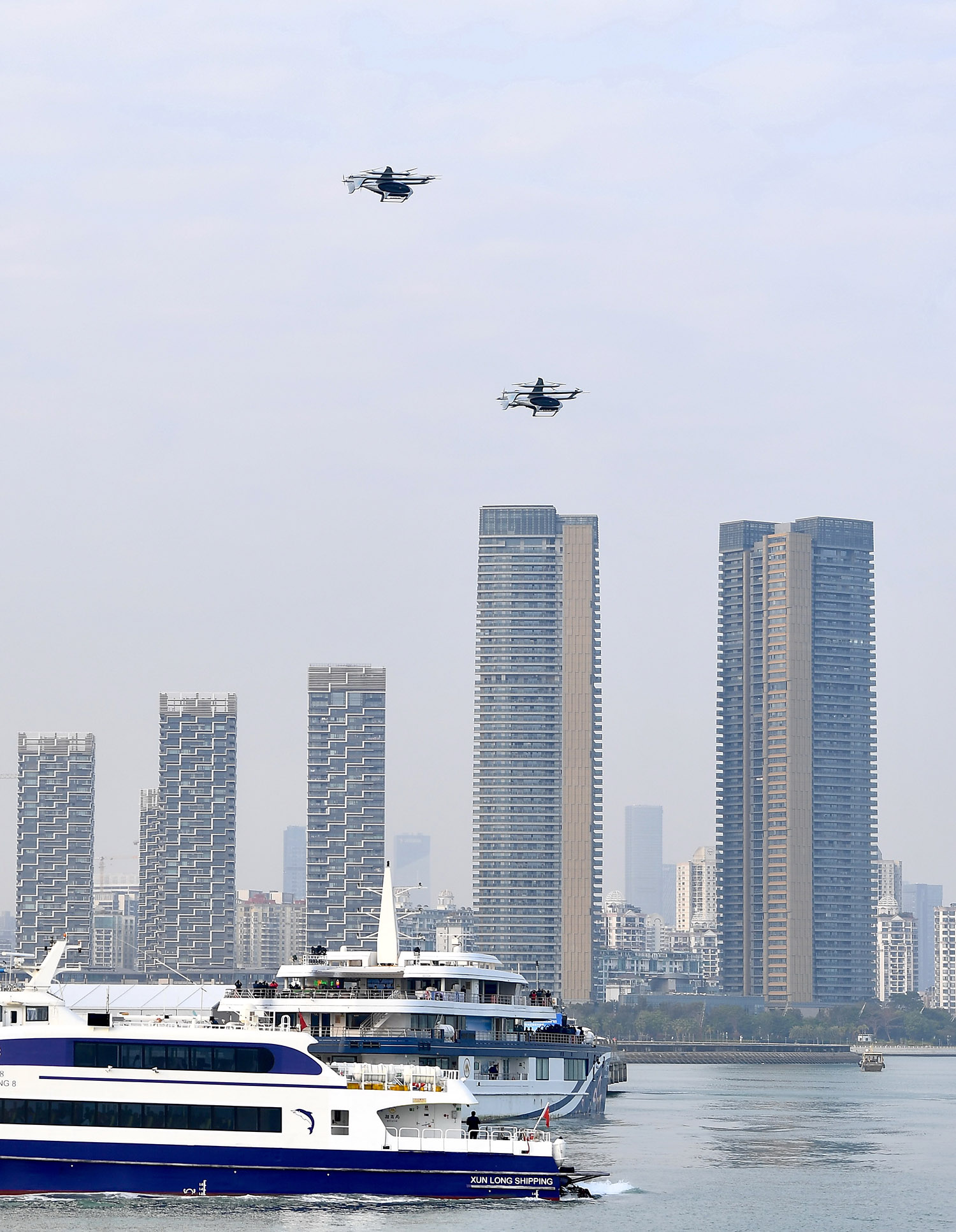More efforts needed to improve rules, standards for safe operation of eVTOLs

China's low-altitude economy, which is regarded as a strategic emerging industry, is poised to see speedy growth in the coming years, fueled mainly by investments in related infrastructure construction, policy support from authorities and commercial applications in diverse scenarios like passenger transport, tourism and logistics, industry experts said.
They noted the country's emphasis on developing the low-altitude economy is conducive to bolstering urban industrial upgrades, fostering new economic growth drivers and alleviating urban traffic congestion, adding that the sector boasts huge market potential and promising development prospects.
However, more efforts should be made to improve the rules, standards and relevant regulatory policies regarding safe operation of unmanned aerial vehicles and other low-altitude flight activities, as well as accelerate the construction of ground takeoff and landing airports and airspace management systems, they added.
Although currently there is no official definition for the "low-altitude economy", it largely refers to a new economic space utilizing low-altitude airspace below 3,000 meters to carry out various airborne activities. These flight activities include a comprehensive range of undertakings focused on both manned and unmanned aerial vehicles, including aircraft manufacturing, low-altitude flight operations and integrated services.
The market scale of China's low-altitude economy reached 505.95 billion yuan ($69.9 billion) in 2023, up 33.8 percent year-on-year, and is expected to surpass 1 trillion yuan in 2026, according to a report released by market research firm CCID Consulting.
Revenue from the electric vertical takeoff and landing sector rose 77.3 percent year-on-year to 980 million yuan last year, the report said. This segment is expected to see wider commercial application in fields like aerial sightseeing and tourism in 2024.
The report estimates that the eVTOL sector will maintain rapid growth in the next few years, with the market scale hitting 9.5 billion yuan in 2026, fueled by the accelerated issuance of airworthiness certifications by authorities. The revenue of the country's civilian drone sector stood at 117.4 billion yuan last year, an increase of 32 percent year-on-year, it added.
Referred to as air taxis, eVTOLs don't require traditional airports or runways. Similar to helicopters, they take off vertically and transition into fixed-wing flight mode in the air, and offer a promising air traffic and sightseeing option while traversing China's congested big cities.
The low-altitude economy, which plays a key part in nurturing new quality productive forces and serves as a new growth engine, has been written into this year's Government Work Report for the first time.
Several provincial-level regions nationwide have unveiled plans to develop the low-altitude economy and build up related industrial clusters in their government work reports in 2024.
Chinese manufacturers of unmanned aerial vehicles, commonly known as drones, are ratcheting up resources to promote the development of the low-altitude economy and expand the application of drones in a wide range of sectors, such as manned transportation, aerial tourism, aerial logistics, agriculture, geological surveying and mapping, public security and even disaster relief.
EHang Holdings Ltd, a Chinese autonomous aerial vehicle tech firm, is stepping up efforts to bolster the commercial use of eVTOL aircraft in aerial sightseeing and tourism.
The company announced in early April that it had obtained a production certificate for its EH216-S passenger-carrying pilotless eVTOL aircraft. The certificate, issued by the Civil Aviation Administration of China, is the world's first production certificate granted in the global eVTOL industry, marking another significant step toward mass production of eVTOL aircraft and follow-up commercial operations.
Previously, the EH216-S had obtained the type certificate and the airworthiness certificate from the CAAC. With a length of 6.05 meters, a width of 5.73 meters and a height of 1.93 meters, the aircraft has a maximum flight range of 30 kilometers and a maximum speed of 130 kilometers per hour.

The low-altitude economy and related sectors present a significant market opportunity for urban air mobility development, and serve as a new engine for future growth in China, said Hu Huazhi, founder, chairman and CEO of EHang.
Hu said the company hopes to introduce safe and reliable pilotless eVTOL aircraft to the global market, thereby offering safe, autonomous and eco-friendly air mobility services to everyone.
EHang recently sold some of its EH216-S models via a livestreaming room on Alibaba Group's online marketplace Taobao. The Guangzhou, Guangdong province-based company has also inked strategic partnerships with some local governments to jointly create a low-altitude economy industry ecosystem.
The certified two-seater EH216-S has successfully completed its inaugural commercial flight demonstrations in Guangzhou and Hefei, Anhui province. The move signified another major milestone toward normalizing EH216-S flights for airborne sightseeing at local scenic spots.
China aims to establish a new development model for the general aviation industry characterized by high-end, intelligent and green features by 2030 and form a trillion-yuan-level market in general aviation equipment, according to a recent action plan issued by the Ministry of Industry and Information Technology and three other government departments.
By 2027, new-generation general aviation equipment with unmanned, electric and intelligent features will realize commercial application in urban air transportation, logistics distribution and emergency rescue, the plan said.
Xpeng AeroHT, a flying car unit of Chinese electric vehicle maker Xpeng Motors, said its flying car will be available for preorders in the fourth quarter of 2024, with delivery to individual users commencing in the fourth quarter of 2025. The vehicle boasts a two-part design, seamlessly switching between terrestrial and aerial modes.
AutoFlight, a Chinese eVTOL aircraft developer, completed the world's first intercity demonstration flight in Guangdong province in February. The company's five-seater eVTOL aircraft could be a faster option for passengers shuttling between Shenzhen and Zhuhai as it takes just 20 minutes compared to a three-hour car ride currently.
AutoFlight has recently delivered its first Prosperity eVTOL aircraft to a customer in Japan, which marks the first global delivery of a civilian eVTOL aircraft weighing over a ton.
Global market consultancy Roland Berger estimates there will be up to 3,000 air taxis in operation by 2025 worldwide, and this figure will increase exponentially to 100,000 by 2050. However, several technological, infrastructural and legal hurdles remain.
Yu Zhanfu, a partner at Roland Berger, said eVTOL aircraft need to go through full verification regarding safety and technological stability in sparsely populated areas or scenarios such as natural landscape tourist destinations in the early stages before they can truly enter the urban air mobility segment.
Compared with traditional helicopters, eVTOL aircraft are smaller, lighter and require less space for takeoffs and landings. They also have lower operating costs, which will give a big boost to their popularity, Yu said. However, they still face technical challenges and uncertainties in various weather and geological conditions.
The CAAC said the number of registered unmanned aerial vehicles or drones in China rose to 1.27 million by the end of 2023, an increase of 32 percent year-on-year.
There were 19,000 enterprises engaged in operating these UAVs or drones. The civilian drones flew a total of 23.11 million hours in the country last year, up 11.8 percent from a year earlier, according to the CAAC.
DJI, the world's largest commercial drone manufacturer by market share, has invested heavily in industry-level drones, which have been widely used in the fields of agriculture, energy, aerial transport and public security, and created great economic and social value.
"The emergence of industry-level drones has reshaped people's lives and production modes, as well as promoted the development of various industries," said Zhang Xiaonan, strategic director of DJI, highlighting that although such drones are still in the initial stage of development, their applications will be more extensive in the future as related technologies advance.
The Shenzhen-based company has been devoting a great deal of attention to farming sector drones in hopes of helping agricultural workers improve the efficiency of sowing seeds and spraying fertilizers and pesticides, as well as increasing the use ratio of intelligent agricultural equipment.
Zhang said DJI will continue to promote the large-scale application of drones in aerial photography, agriculture, inspection and mapping, as well as transportation, and continuously expand new application scenarios to bolster the growth of the low-altitude economy.
Han Jun, deputy head of the CAAC, said as a strategic emerging industry, the low-altitude economy has a long industrial chain, covering sectors such as aircraft R&D and manufacturing, low-altitude flight infrastructure construction and operation, and flight services.
Han said that the CAAC is promoting the construction of a low-altitude flight service system and seeks to simplify application and approval procedures for low-altitude flight plans.
Yang Jincai, director of the Shenzhen Unmanned Aerial Vehicle Industry Association in Guangdong province, said apart from traditional application scenarios such as agriculture, forestry, crop surveys, security monitoring, geographic mapping, as well as emergency rescues and logistics, the application scope of the low-altitude economy will be more extensive and diverse in the future.
However, the sector is still in its initial stage of development in China due to security considerations, and there is a lack of effective supervision and emergency response mechanisms regarding low-altitude flight activities, which also presents some difficulties for urban low-altitude airspace management, Yang said.
He called for efforts to further improve the design and planning of low-altitude airspace to make full use of airspace resources and meet the needs of various aviation activities, strengthen supervision and management of flight activities, and maintain the order of airspace.
Yang Sumei, an associate professor at Guangzhou Maritime University, said more efforts are needed to accelerate the construction of low-altitude infrastructure alongside intelligent management and operating platforms, as well as establish applicable rules and standards to better regulate the fast-developing sector.


